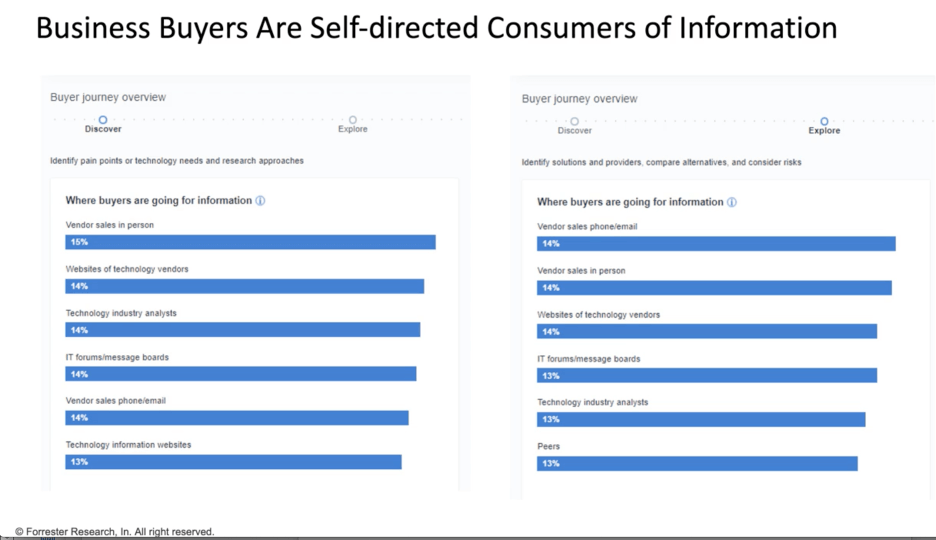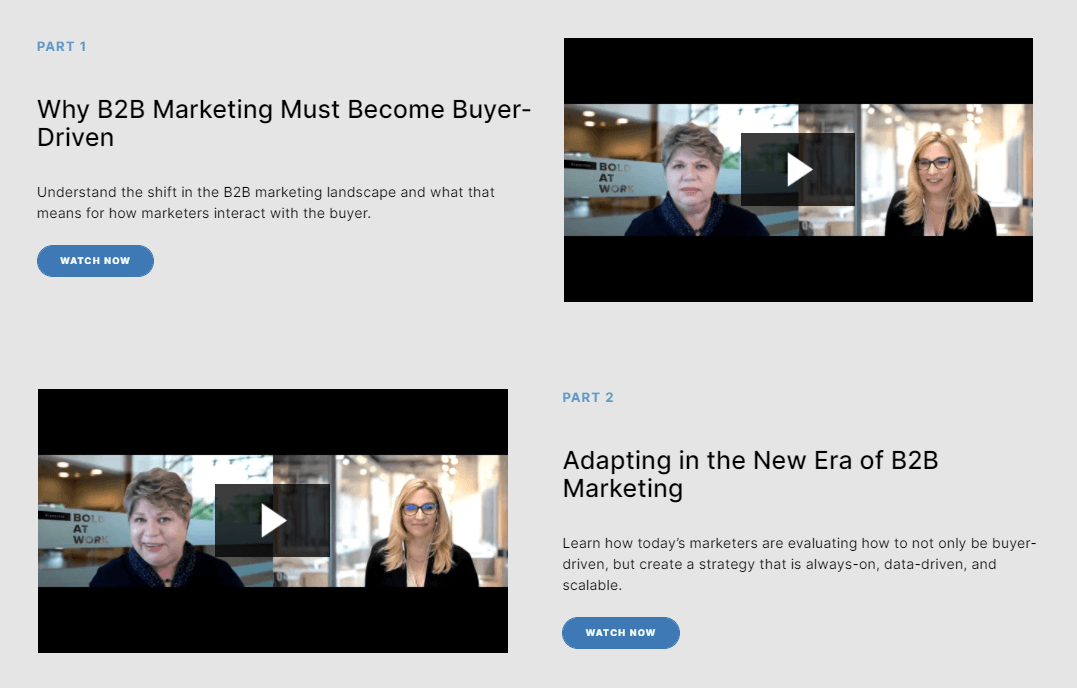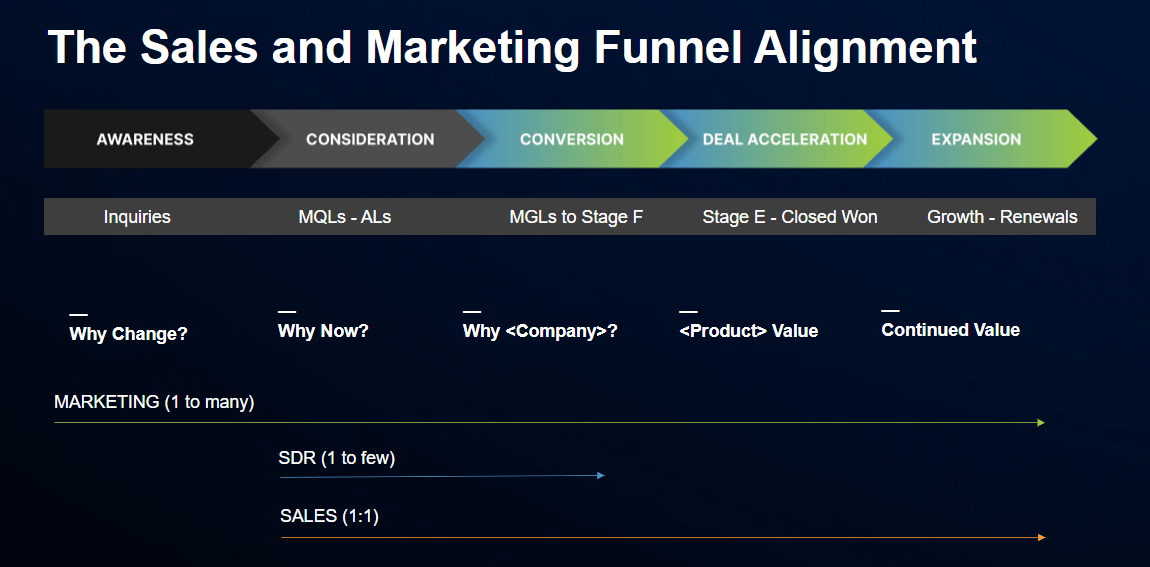Your buyer is telling you their story. But are you listening?
Do you remember the days when B2B marketers talked about a linear buyer’s journey that neatly moved through our precisely tuned marketing and sales funnel? Unfortunately, if those days ever existed outside of our PowerPoint decks, they’re definitely not the reality of today’s complex buyer’s journey.
Today, it’s a whole new world out there for B2B marketers and salespeople. The recent Forrester B2B Summit underscored the idea that B2B buyers are firmly in charge. Buyers are telling us what they need from us, after they’ve amassed a ton of self-directed research and recommendations from their peers.

In fact, Forrester data, as seen above, shows that now, our sales and marketing teams’ influence and impact are in concert with several other information sources to make up the critical stages of the new buyer’s process.
But that doesn’t mean we’ve lost our opportunity to influence the digital buyer’s journey. Instead, B2B Marketers must adapt to the new omnichannel realities of the non-linear, self-serve buyer’s journey. It’s all about anticipating and responding to the buyer with what they need at that moment in time when they are in the market.
The key to connecting with today’s B2B buyer is to be buyer-centric in every communication and interaction, provide an integrated, omnichannel experience, and bridge internal siloes with ever-evolving sales and marketing orchestration.
What it Means to Truly Be Buyer-Centric

The buyer’s journey is now really the buyer’s process—and it often contains multiple stakeholders engaging in their own research and conversations across a myriad of communication channels and platforms.
When buyers are ready to talk to us, they expect us to have that conversation with them across multiple digital, self-directed channels asynchronously. But that’s not all—they also expect us to respond with a holistic view of where they are in their process and awareness of all the interactions that have come before the current conversation. This means listening, making sure we are meeting them where they are, and responding in a contextual way.
“It’s a blended delivery model [for sales and marketing] across the entire customer lifecycle, all [channels] are blended together in a customer engagement strategy that’s really calibrated to the customer’s journey,” says Lori Wizdo VP, Principal Analyst, Forrester. For more from Lori on the importance of being buyer-obsessed , check out the recordings of our recent conversation with her on marketers’ strategic opportunity as go-to-customer experts and what it truly means to move to a buyer-driven approach.

This is not an easy adjustment! For many companies, this sort of orchestrated omnichannel approach has been aspirational. It was part of a digital transformation project that we expected to build. But today, that aspiration needs to be converted into reality ASAP for B2B organizations to continue to grow our customer bases.
We must pivot to what we call Precision Demand Marketing, meeting the buyer where they are in their digital watering holes if we hope to survive in this buyer’s world. So focus on the buyer and hold on tight—I’m confident there is more change to come.
Expectations for The New Omnichannel Marketing Mix
As marketers work to build bridges with their sales teams to meet customer needs, customers are getting impatient, and in some cases, taking their business elsewhere if we can’t deliver.
In the fourth edition of the Salesforce State of the Connected Customer, 54% percent of customers say it generally feels like sales, service, and marketing don’t share information. Further, 57% of buyers say sales reps often lack adequate knowledge of their business.
Unhappy prospects aren’t just accepting this disconnect as an annoyance. Instead, they’re taking their business to companies that are buyer-obsessed and put in that extra effort for differentiated connections. So what are some of those unmet buyer expectations? From the same Salesforce research:
- 84% of business buyers are more likely to buy from a company that demonstrates an understanding of their business goals.
- 83% of customers expect to engage with someone immediately when contacting a company — up from 78% in 2019.
- 79% expect consistent interactions across departments
Developing Omnichannel Experiences Across the Buyer’s Process
If marketers had a dollar for every executive that said, “do more of this channel” or “don’t spend in that channel anymore,” we’d all be rich! The thing is, it doesn’t matter what channels we — or our executives — like. Our marketing mix has to reflect where the buyer is doing their research, and understanding what influences their decision.
“The approach needs to be multi-channel, and we see this works much better when we position ourselves in the ‘watering holes’ people go to rather than the ones we try to create ourselves,” says Leslie Alore, Global Vice President Growth Marketing, Ivanti. “This is exactly why we work with Integrate — they allow us to be hyper-targeted to the accounts we want and put our messages in the places our audience is…then continue to retarget to them in various ways (beyond content syndication).” For more from Leslie, check out the replay of our recent webinar, Building a Global Demand Center with Precision at Scale.
Yes, it’s still aspirational for marketers to reach omnichannel marketing nirvana. We will always have time constraints. There is never enough budget or resources to anticipate and execute in every channel that could conceivably influence a buyer’s purchase decision.
But that doesn’t mean we can just put together an ABM strategy and call it a day, either. Make no mistake; a full journey marketer understands that creating a consistent multi-channel buyer experience is essential to delivering a differentiated brand connection. This includes not only the content we create and our marketing channels, but also the orchestration process. Your Martech stack is only as powerful as the process behind it.
A Framework to Align the Sales and Marketing Funnel

We’ve all received too many irrelevant, disconnected marketing emails. But imagine if you received a thoughtfully written email from a company that had done its research. Chances are you’d feel like you must hear them out because they’ve invested their time in you before asking you to invest your time in them. That’s how you build brand trust.
To spur your thinking of the potential impact across the funnel, I’ve shared the above framework, which I use to think about our internal orchestration process. You’ll see it includes SDRs taking the time for personalized outreach to the buying committee and Sales talking to the Executive Champion when they want to talk.
Think it looks too good to be true? Sometimes it is more aspirational than the reality of a specific deal. But the point is, it’s the aspirational ideal we, across the organization, are working toward. Every day, with every marketing program, we’re asking, “how can we be more buyer-centric in our approach?”
We’re only scratching the surface here on sales and marketing orchestration, though. So stay tuned for a deeper dive into how to build an SDR playbook that can bring this all together.
Consider it a call to arms to be thinking about how we can shift our roles and aligning to the buyer’s perspective. For more inspiration on adapting to the new buyer’s process in your organization, check out the Response to Revenue webinar.








